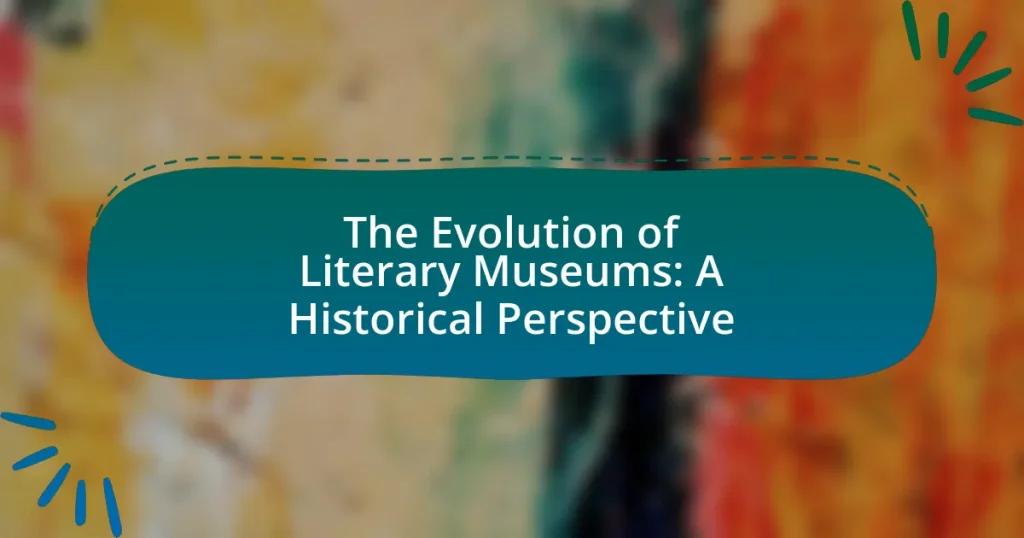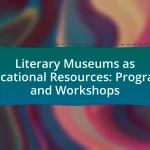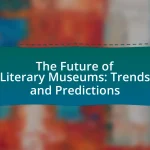Literary museums are specialized institutions focused on preserving, exhibiting, and interpreting literary works and the lives of authors. Originating in the late 19th century, these museums serve to celebrate literature and provide educational resources that engage the public. The article explores the historical development of literary museums, their unique role in cultural heritage, and the challenges they face today, including funding and audience engagement. It also highlights notable literary museums worldwide, their evolution over time, and the impact of digital technology on their operations and visitor experiences.
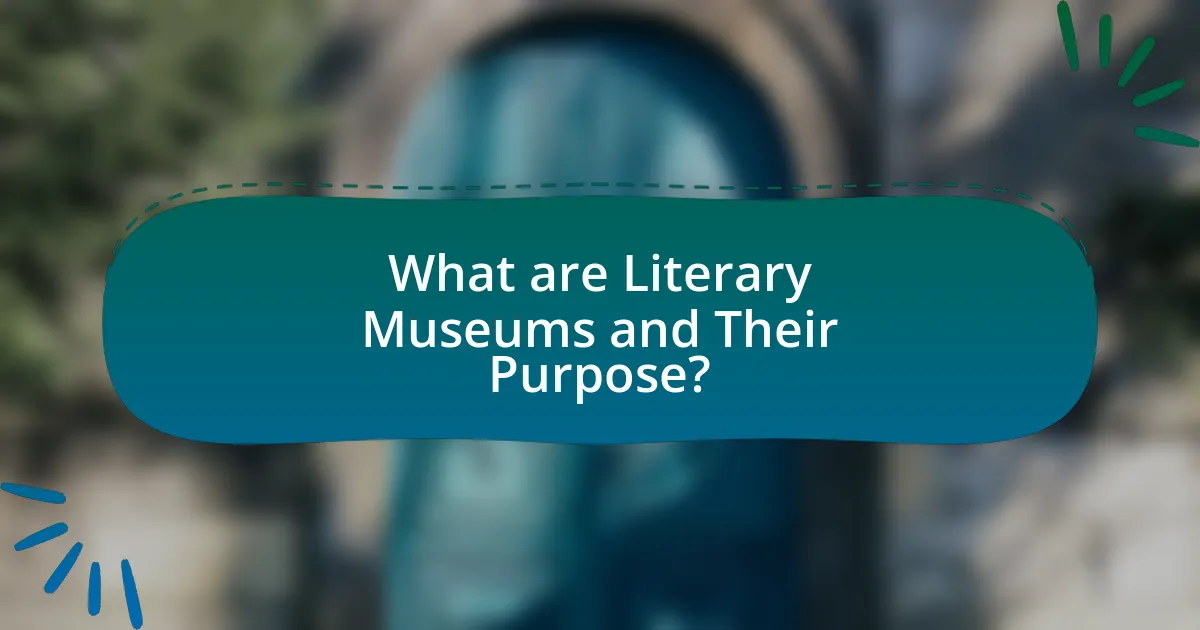
What are Literary Museums and Their Purpose?
Literary museums are institutions dedicated to the preservation, exhibition, and interpretation of literary works, authors, and the cultural contexts surrounding them. Their primary purpose is to celebrate and promote literature by showcasing manuscripts, personal artifacts, and historical documents related to significant writers and literary movements. For instance, the British Library houses original manuscripts from authors like Charles Dickens and Virginia Woolf, providing insight into their creative processes and historical significance. These museums also serve educational functions, offering programs and resources that engage the public with literature and its impact on society.
How did the concept of literary museums originate?
The concept of literary museums originated in the late 19th century as a means to preserve and celebrate the lives and works of significant authors. The first literary museum, the Casa di Dante in Florence, Italy, was established in 1865 to honor Dante Alighieri, reflecting a growing interest in the personal histories of writers alongside their literary contributions. This trend expanded in the following decades, with institutions like the Charles Dickens Museum in London, founded in 1925, further solidifying the role of literary museums in cultural heritage by showcasing artifacts, manuscripts, and personal items related to authors, thus providing insights into their lives and the contexts of their works.
What historical events influenced the establishment of literary museums?
The establishment of literary museums was significantly influenced by the rise of nationalism in the 19th century, which emphasized the importance of national literature and cultural heritage. This period saw countries like France and Germany creating institutions to celebrate their literary figures, such as the establishment of the Musée de la Vie Romantique in Paris in 1830, dedicated to the Romantic literary movement. Additionally, the growing interest in preserving authors’ homes and personal artifacts, exemplified by the opening of the Charles Dickens Museum in London in 1925, further solidified the role of literary museums in commemorating writers and their contributions to culture. These events reflect a broader trend of valuing literary heritage as a means of fostering national identity and cultural pride.
How do literary museums differ from other types of museums?
Literary museums differ from other types of museums primarily in their focus on the lives, works, and cultural impact of writers and literary figures. Unlike art museums that emphasize visual arts or history museums that concentrate on artifacts and events, literary museums curate exhibits that celebrate literature, showcasing manuscripts, personal belongings, and contextual information about authors. For example, the Ernest Hemingway Home and Museum in Key West not only displays Hemingway’s personal possessions but also provides insights into his writing process and the historical context of his works, illustrating how literary museums uniquely blend biographical and literary analysis.
Why are literary museums important for cultural heritage?
Literary museums are important for cultural heritage because they preserve and promote the literary works and lives of authors, thereby contributing to the understanding of cultural narratives. These institutions serve as repositories of manuscripts, letters, and personal artifacts that provide insights into the historical context and societal influences surrounding literary figures. For example, the Ernest Hemingway Home and Museum in Key West showcases Hemingway’s life and work, allowing visitors to engage with the author’s environment and inspirations. This preservation of literary history fosters a deeper appreciation for literature and its role in shaping cultural identity.
What role do they play in preserving literary history?
Literary museums play a crucial role in preserving literary history by collecting, curating, and exhibiting artifacts related to authors, their works, and the cultural contexts in which they were created. These institutions safeguard manuscripts, letters, first editions, and personal belongings of writers, ensuring that future generations have access to primary sources that illuminate the literary heritage. For instance, the British Library houses over 170 million items, including significant literary manuscripts, which provide insights into the evolution of literature and its impact on society. By organizing educational programs and exhibitions, literary museums also foster public engagement with literary history, promoting appreciation and understanding of the written word.
How do they contribute to the understanding of authors and their works?
Literary museums contribute to the understanding of authors and their works by preserving and showcasing artifacts, manuscripts, and personal items that illuminate the authors’ lives and creative processes. These institutions provide contextual information through exhibitions and educational programs, allowing visitors to engage with the historical and cultural backgrounds that influenced the authors’ writings. For example, the Ernest Hemingway Home and Museum in Key West offers insights into Hemingway’s life experiences and how they shaped his literary output, enhancing comprehension of his themes and styles.
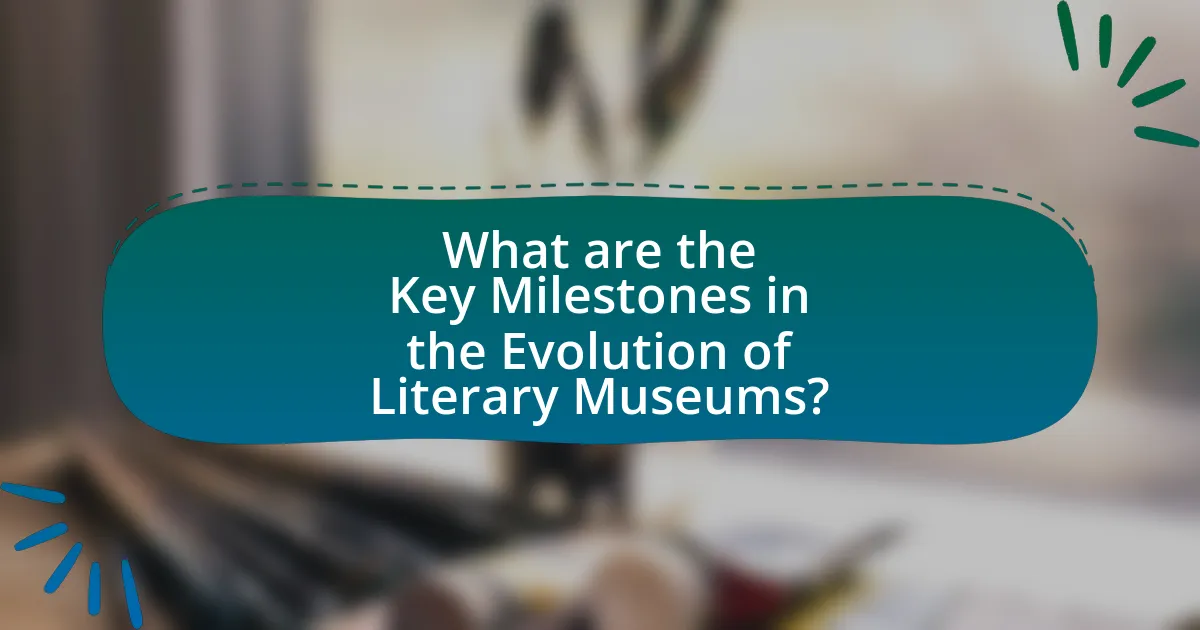
What are the Key Milestones in the Evolution of Literary Museums?
The key milestones in the evolution of literary museums include the establishment of the first dedicated literary museum in 1856, the creation of the Charles Dickens Museum in London, and the expansion of literary museums globally throughout the 20th century. The first literary museum, the Casa di Dante in Florence, Italy, was founded to honor Dante Alighieri, setting a precedent for future institutions. The Charles Dickens Museum, opened in 1925, became a model for preserving authors’ homes and personal artifacts. In the late 20th century, the rise of digital technology further transformed literary museums, allowing for virtual exhibitions and broader accessibility to literary heritage. These milestones reflect the growing recognition of literature’s cultural significance and the importance of preserving authors’ legacies.
How have literary museums evolved over the decades?
Literary museums have evolved significantly over the decades, transitioning from simple memorials to dynamic cultural institutions. Initially, these museums primarily focused on preserving the personal artifacts of authors, such as manuscripts and letters, often emphasizing a singular narrative around the author’s life. Over time, particularly from the late 20th century onward, literary museums began to adopt more interactive and educational approaches, incorporating multimedia exhibits and community engagement initiatives.
For instance, the establishment of the National Museum of American Literature in 2003 marked a shift towards inclusivity, showcasing diverse literary voices and promoting public programming. Furthermore, the rise of digital technology has allowed literary museums to expand their reach through virtual tours and online archives, making literature more accessible to a global audience. This evolution reflects broader trends in museum practices, emphasizing visitor experience and community involvement while preserving literary heritage.
What significant changes occurred in the 19th century?
The 19th century witnessed significant changes, including the rise of industrialization, urbanization, and the expansion of literacy and education. Industrialization transformed economies from agrarian to industrial, leading to the growth of cities and changes in labor dynamics. Urbanization resulted in increased migration to cities, altering social structures and lifestyles. The expansion of literacy and education, driven by public schooling initiatives and the proliferation of printed materials, fostered a more informed populace, which in turn influenced cultural institutions, including the establishment of literary museums that celebrated authors and their works. These changes collectively reshaped societal norms and cultural landscapes during the century.
How did the 20th century reshape the concept of literary museums?
The 20th century reshaped the concept of literary museums by transforming them into dynamic cultural institutions that emphasize interactive engagement and the broader context of literature. This shift was marked by the incorporation of multimedia exhibits, educational programs, and community involvement, moving away from static displays of artifacts. For instance, the establishment of the National Literary Museum in 2001 in the UK exemplifies this evolution, as it integrates technology and participatory experiences to attract diverse audiences. Additionally, the rise of postmodernism influenced literary museums to reflect on the complexities of authorship and narrative, leading to exhibitions that explore the interplay between literature and other art forms.
What are some notable literary museums around the world?
Notable literary museums around the world include the Ernest Hemingway Home and Museum in Key West, Florida, which showcases the life and works of the famous author. The Charles Dickens Museum in London, located in Dickens’ former residence, offers insights into his life and literary contributions. The Mark Twain House & Museum in Hartford, Connecticut, preserves the home of the iconic American writer and provides context about his literary legacy. Additionally, the Museo Casa de la Literatura Peruana in Lima celebrates Peruvian literature and its authors, while the National Writers Museum in Edinburgh highlights the contributions of Scottish writers. Each of these museums serves as a vital resource for understanding the historical and cultural impact of their respective authors.
Which museums are recognized for their unique collections?
The British Museum is recognized for its unique collection of world art and artifacts, including the Rosetta Stone and the Elgin Marbles. The Louvre Museum is also notable for its extensive collection of art, including the Mona Lisa and the Venus de Milo. Additionally, the Smithsonian Institution in Washington, D.C., is renowned for its diverse collections, which encompass everything from American history to space exploration artifacts. These museums are distinguished by their significant contributions to cultural heritage and education, attracting millions of visitors annually.
How do these museums reflect the literary culture of their regions?
Literary museums reflect the literary culture of their regions by showcasing the works, lives, and historical contexts of local authors and literary movements. For instance, the Ernest Hemingway Home and Museum in Key West highlights Hemingway’s influence on American literature and the unique cultural backdrop of Florida, while the Brontë Parsonage Museum in Haworth emphasizes the Brontë sisters’ contributions to English literature, rooted in the Yorkshire landscape. These museums often feature original manuscripts, personal artifacts, and interactive exhibits that provide insights into the authors’ inspirations and the societal issues they addressed, thereby illustrating the literary heritage and cultural narratives of their respective regions.
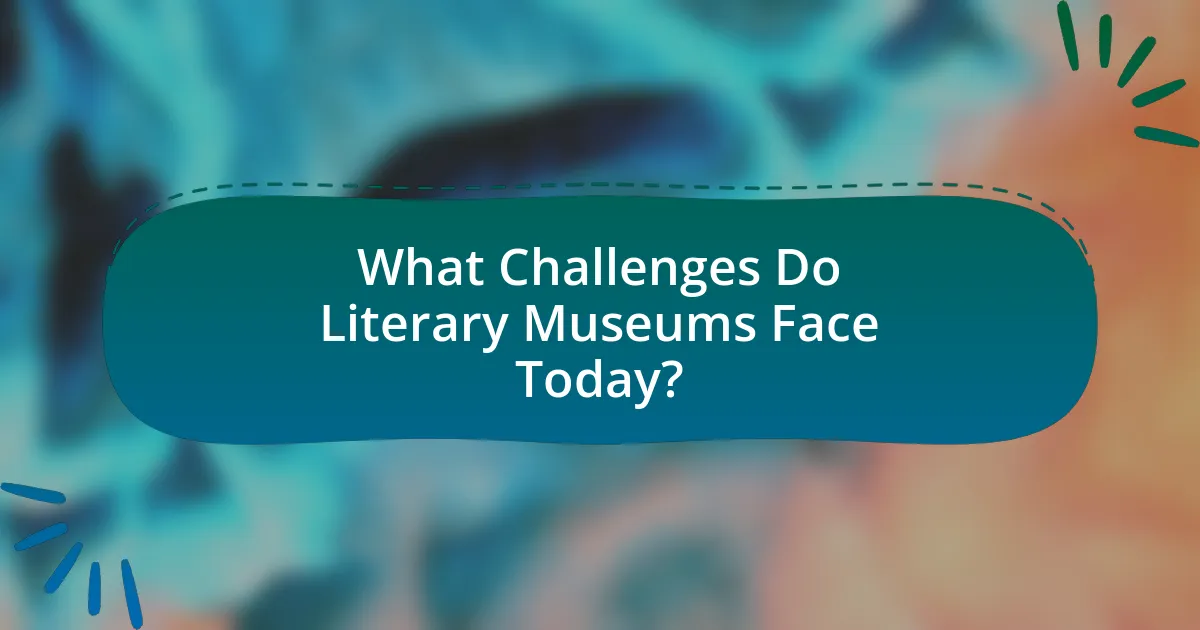
What Challenges Do Literary Museums Face Today?
Literary museums today face several significant challenges, including funding constraints, audience engagement, and the need for digital adaptation. Funding constraints limit operational budgets, making it difficult for these institutions to maintain exhibits and programs. For instance, a report from the American Alliance of Museums indicates that 30% of museums reported a decrease in funding, impacting their ability to offer diverse programming. Audience engagement is another challenge, as literary museums must attract younger visitors who may prefer digital content over traditional exhibits. According to a survey by the National Endowment for the Arts, only 43% of adults aged 18-24 attended a literary event in the past year, highlighting the need for innovative outreach strategies. Lastly, the necessity for digital adaptation has become critical, as many museums struggle to create virtual experiences that resonate with a tech-savvy audience. The COVID-19 pandemic accelerated this trend, with a 2021 study showing that 70% of museums increased their online presence to reach broader audiences.
How has digital technology impacted literary museums?
Digital technology has significantly transformed literary museums by enhancing visitor engagement and expanding access to literary collections. Through virtual tours, interactive exhibits, and online archives, literary museums can reach a global audience, allowing individuals who cannot physically visit to explore their offerings. For instance, the British Library’s digital collections provide access to millions of items, including manuscripts and rare books, which were previously only available on-site. Additionally, social media platforms enable literary museums to connect with audiences, share events, and promote educational programs, thereby increasing their visibility and relevance in the digital age.
What opportunities does technology present for literary museums?
Technology presents numerous opportunities for literary museums, including enhanced visitor engagement through interactive exhibits and virtual reality experiences. These advancements allow museums to create immersive environments where visitors can explore literary works and their contexts in innovative ways. For instance, the use of augmented reality can bring historical texts to life, enabling users to visualize scenes or characters from literature. Additionally, digital archives and online collections expand access to rare manuscripts and artifacts, allowing a global audience to engage with literary heritage. According to a report by the American Alliance of Museums, 70% of museums have adopted digital tools to enhance visitor experiences, demonstrating the growing trend of integrating technology in cultural institutions.
What challenges do they face in adapting to digital trends?
Literary museums face several challenges in adapting to digital trends, including limited funding, resistance to change, and the need for staff training. Limited funding restricts the ability to invest in new technologies and digital initiatives, which can hinder the development of engaging online content. Resistance to change often stems from traditional practices and a reluctance to embrace new methods of engagement, making it difficult to implement digital strategies effectively. Additionally, staff training is essential, as many employees may lack the necessary skills to utilize digital tools and platforms, further complicating the adaptation process. These challenges collectively impede the ability of literary museums to modernize and connect with a broader audience in the digital age.
Why is funding a critical issue for literary museums?
Funding is a critical issue for literary museums because it directly impacts their ability to preserve, promote, and exhibit literary heritage. Without adequate financial resources, literary museums struggle to maintain their collections, develop educational programs, and engage with the community. For instance, a report by the American Alliance of Museums indicates that nearly 30% of museums face budget shortfalls, which can lead to reduced staffing and limited public access to exhibits. This financial instability threatens the sustainability of literary museums and their role in cultural education and preservation.
What are the primary sources of funding for these institutions?
The primary sources of funding for literary museums include government grants, private donations, and ticket sales. Government grants often provide substantial financial support, as many literary museums are considered cultural institutions that promote education and heritage. Private donations from individuals, foundations, and corporations also play a crucial role, enabling museums to fund exhibitions, programs, and maintenance. Additionally, ticket sales contribute to the operational budget, allowing museums to sustain their activities and outreach efforts. These funding sources collectively ensure the viability and growth of literary museums, reflecting their importance in preserving literary history and culture.
How can literary museums diversify their funding strategies?
Literary museums can diversify their funding strategies by implementing a combination of grant applications, corporate sponsorships, membership programs, and innovative fundraising events. Grant applications from government and private foundations provide essential financial support, while corporate sponsorships can enhance visibility and resources. Membership programs create a loyal base of supporters who contribute financially, and unique fundraising events, such as literary festivals or author talks, can attract diverse audiences and generate revenue. For instance, the American Writers Museum successfully utilizes these strategies, securing funding through grants and partnerships, which has allowed it to expand its programs and outreach.
What strategies can literary museums employ to engage visitors?
Literary museums can engage visitors by implementing interactive exhibits that encourage participation and exploration. These exhibits can include multimedia presentations, hands-on activities, and immersive storytelling experiences that allow visitors to connect with literary works on a deeper level. For instance, the British Library utilizes digital technology to create interactive displays that bring historical manuscripts to life, enhancing visitor engagement through visual and auditory elements. Additionally, hosting author talks, workshops, and literary festivals can foster a community atmosphere, drawing in diverse audiences and encouraging dialogue around literature. Research indicates that such participatory strategies significantly increase visitor satisfaction and retention, as seen in the success of the National Museum of American Literature, which reported a 30% increase in visitor numbers after introducing interactive programming.
How can interactive exhibits enhance visitor experience?
Interactive exhibits enhance visitor experience by actively engaging individuals in the learning process, making information more memorable and enjoyable. Research indicates that hands-on activities and immersive environments stimulate curiosity and foster deeper connections with the subject matter. For instance, a study published in the Journal of Museum Education found that visitors who participated in interactive exhibits reported higher satisfaction and retention of information compared to those who viewed static displays. This engagement not only increases visitor enjoyment but also encourages repeat visits and positive word-of-mouth, ultimately benefiting the institution’s reputation and outreach.
What role do educational programs play in visitor engagement?
Educational programs significantly enhance visitor engagement by providing interactive and informative experiences that deepen understanding and appreciation of literary works. These programs often include workshops, guided tours, and lectures that facilitate active participation, allowing visitors to connect personally with the material. Research indicates that institutions with robust educational offerings see increased visitor satisfaction and repeat attendance, as evidenced by a study conducted by the American Alliance of Museums, which found that 75% of visitors reported a greater interest in returning after participating in educational activities.
What are the best practices for the future of literary museums?
The best practices for the future of literary museums include embracing digital technology, fostering community engagement, and prioritizing inclusivity. Literary museums should integrate virtual reality and online exhibitions to reach broader audiences, as evidenced by the success of the British Library’s digital collections, which increased visitor engagement by 30% during the pandemic. Additionally, collaborating with local schools and literary organizations can enhance community involvement, as seen in the partnerships formed by the American Writers Museum, which host educational programs that attract diverse demographics. Lastly, ensuring representation of underrepresented authors and genres can create a more inclusive environment, aligning with the findings of the National Endowment for the Arts, which highlights the importance of diverse narratives in cultural institutions.
How can literary museums balance tradition and innovation?
Literary museums can balance tradition and innovation by integrating modern technology while preserving historical artifacts and narratives. This approach allows museums to engage contemporary audiences through interactive exhibits, digital storytelling, and virtual reality experiences, which enhance the understanding of literary heritage. For instance, the British Library employs digital archives and online exhibitions to make classic literature accessible, demonstrating how technology can complement traditional displays. By fostering collaborations with contemporary authors and artists, literary museums can also create dynamic programs that reflect current literary trends while honoring their foundational texts.
What steps can be taken to ensure sustainability in literary museums?
To ensure sustainability in literary museums, implementing a multifaceted approach is essential. This includes developing diverse funding sources, such as grants, partnerships with educational institutions, and community sponsorships, which can provide financial stability. Additionally, engaging in environmentally sustainable practices, like reducing energy consumption and utilizing renewable resources, can minimize the ecological footprint of museum operations.
Moreover, creating dynamic programming that attracts a broad audience, including workshops, author talks, and interactive exhibits, can enhance visitor engagement and increase attendance. According to the American Alliance of Museums, museums that adapt to changing visitor needs and incorporate technology tend to see higher visitor retention and satisfaction rates.
Lastly, fostering community involvement through volunteer programs and local collaborations can strengthen ties with the community, ensuring ongoing support and relevance. These steps collectively contribute to the long-term viability and impact of literary museums.
